Anticancer Activity and Apoptosis Induction of Gold(III) Complexes Containing 2,2′-Bipyridine-3,3′-dicarboxylic Acid and Dithiocarbamates
Abstract
:1. Introduction
2. Results and Discussion
2.1. Synthesis and Spectroscopic Characterization
2.2. Cytotoxic Activity
2.3. Apoptosis Induction
2.4. DNA Damage
2.5. Stability of Complexes 1 and 3
2.6. Effect on ROS Level
2.7. Effect on Mitochondrial Membrane Potential
3. Experiment and Instrumentation
3.1. Materials
3.2. Instrumentation
3.3. Synthesis of [Au(Bipydc))Cl2]Cl (A)
3.4. Synthesis of Complexes 1–3
3.5. Analysis
3.6. In Vitro Cytotoxicity Assay
3.7. Apoptosis Analysis for Complex 2
3.8. DNA Damage of Complex 2
3.9. ROS Production of Complex 2
3.10. Mitochondrial Membrane Potential of Complex 2
3.11. Statistical Analysis
4. Conclusions
Author Contributions
Funding
Institutional Review Board Statement
Informed Consent Statement
Data Availability Statement
Acknowledgments
Conflicts of Interest
Sample Availability
References
- Johnstone, T.C.; Suntharalingam, K.; Lippard, S.J. The Next Generation of Platinum Drugs: Targeted Pt(II) Agents, Nanoparticle Delivery, and Pt(IV) Prodrugs. Chem. Rev. 2016, 116, 3436–3486. [Google Scholar] [CrossRef] [PubMed] [Green Version]
- Dilruba, S.; Kalayda, G.V. Platinum-based drugs: Past, present and future. Cancer Chemother. Pharmacol. 2016, 77, 1103–1124. [Google Scholar] [CrossRef] [PubMed]
- Ahmad, S. Kinetic aspects of platinum anticancer agents. Polyhedron 2017, 138, 109–124. [Google Scholar] [CrossRef]
- Wheate, N.J.; Walker, S.; Craig, G.E.; Oun, R. The status of platinum anticancer drugs in the clinic and in clinical trials. Dalton Trans. 2010, 39, 8113–8127. [Google Scholar] [CrossRef] [PubMed] [Green Version]
- Bertrand, B.; Williams, M.R.M.; Bochmann, M. Gold(III) Complexes for Antitumor Applications: An Overview. Chem. A Eur. 2018, 24, 11840–11851. [Google Scholar] [CrossRef]
- Ott, I. On the medicinal chemistry of gold complexes as anticancer drugs. Coord. Chem. Rev. 2009, 253, 1670–1681. [Google Scholar] [CrossRef]
- Zhang, C.; Maddelein, M.L.; Wai-Yin, S.R.; Gornitzka, H.; Cuvillier, O.; Hemmert, C. Pharmacomodulation on Gold-NHC complexes for anticancer applications- is lipophilicity the key point? Eur. J. Med. Chem. 2018, 157, 320–332. [Google Scholar] [CrossRef]
- Gabbiani, C.; Casini, A.; Messori, L. Gold(III) compounds as anticancer drugs. Gold Bull. 2007, 40, 73–81. [Google Scholar] [CrossRef] [Green Version]
- Carotti, S.; Guerrib, A.; Mazzei, T.; Messori, L.; Mini, E.; Orioli, P. Gold(III) compounds as potential antitumor agents: Cytotoxicity and DNA binding properties of some selected polyamine-gold(III) complexes. Inorg. Chim. Acta 1998, 281, 90–94. [Google Scholar] [CrossRef]
- Messori, L.; Abbate, F.; Marcon, G.; Orioli, P.; Fontani, M.; Mini, E.; Mazzei, T.; Carotti, S.; O’Connell, T.; Zanello, P. Gold(III) complexes as potential antitumor agents: Solution chemistry and cytotoxic properties of some selected gold(III) compounds. J. Med. Chem. 2000, 43, 3541–3548. [Google Scholar] [CrossRef]
- Marcon, G.; Carotti, S.; Coronnello, M.; Messori, L.; Mini, E.; Orioli, P.; Mazzei, T.; Cinellu, M.A.; Minghetti, G. Gold(III) complexes with bipyridyl ligands: Solution chemistry, cytotoxicity, and DNA binding properties. J. Med. Chem. 2002, 45, 1672–1677. [Google Scholar] [CrossRef]
- Casini, A.; Cinellu, M.A.; Minghetti, G.; Gabbiani, C.; Coronnello, M.; Mini, E.; Messori, L. Structural and solution chemistry, antiproliferative effects, and DNA and protein binding properties of a series of dinuclear gold(III) compounds with bipyridyl ligands. J. Med. Chem. 2006, 49, 5524–5531. [Google Scholar] [CrossRef]
- Casini, A.; Diawara, M.C.; Scopelliti, R.; Zakeeruddin, S.M.; Grätzel, M.; Dysona, P.J. Synthesis, characterisation and biological properties of gold(III) compounds with modified bipyridine and bipyridylamine ligands. Dalton Trans. 2010, 39, 2239–2245. [Google Scholar] [CrossRef] [PubMed]
- Khan, T.-M.; Gul, N.S.; Lu, X.; Wei, J.-H.; Liu, Y.-C.; Sun, H.; Liang, H.; Orvig, C.; Chena, Z.-F. In vitro and in vivo anti-tumor activity of two gold(III) complexes with isoquinoline derivatives as ligands. Eur. J. Med. Chem. 2019, 163, 333–343. [Google Scholar] [CrossRef]
- Martín-Santos, C.; Michelucci, E.; Marzo, T.; Messori, L.; Szumlas, P.; Bednarski, P.J.; Mas-Balleste, R.; Navarro-Ranninger, C.; Cabrera, S.; Alemán, J. Gold(III) complexes with hydroxyquinoline, aminoquinoline and quinoline ligands: Synthesis, cytotoxicity, DNA and protein binding studies. J. Inorg. Biochem. 2015, 153, 339–345. [Google Scholar] [CrossRef]
- Altaf, M.; Ahmad, S.; Kawde, A.-N.; Baig, N.; Alawad, A.; Altuwaijri, S.; Helen Stoeckli-Evansf, H.; Isab, A.A. Synthesis, structural characterization, electrochemical behavior and anticancer activity of gold(III) complexes of meso-1,2-di(1-naphthyl)-1,2-diaminoethane and tetraphenylporphyrin. New J. Chem. 2016, 40, 8288–8295. [Google Scholar] [CrossRef]
- Pantelić, N.; Zmejkovski, B.B.; Kolundžija, B.; Crnogorac, M.Đ.; Vujić, J.M.; Dojčinović, B.; Trifunović, S.R.; Stanojković, T.P.; Sabo, T.J.; Kaluđerović, G.N. In vitro antitumor activity, metal uptake and reactivity with ascorbic acid and BSA of some gold(III) complexes with N,N′-ethylenediamine bidentate ester ligands. J. Inorg. Biochem. 2017, 172, 55–66. [Google Scholar] [CrossRef] [PubMed] [Green Version]
- Durovic, M.D.; Bugarcic, Z.D.; Van Eldik, R. Stability and reactivity of gold compounds—From fundamental aspects to applications. Coord. Chem. Rev. 2017, 338, 186–206. [Google Scholar] [CrossRef]
- Altaf, M.; Casagrande, N.; Mariotto, E.; Baig, N.; Kawde, A.-N.; Corona, G.; Larcher, R.; Borghese, C.; Pavan, C.; Seliman, A.A.; et al. Potent In Vitro and In Vivo Anticancer Activity of New Bipyridine and Bipyrimidine Gold(III) Dithiocarbamate Derivatives. Cancers 2019, 11, 474. [Google Scholar] [CrossRef] [Green Version]
- Altaf, M.; Monim-Ul-Mehboob, M.; Kawde, A.-N.; Corona, G.; Larcher, R.; Ogasawara, M.; Casagrande, N.; Celegato, M.; Borghese, C.; Siddik, Z.H.; et al. New bipyridine gold(III) dithiocarbamate-containing complexes exerted a potent anticancer activity against cisplatin-resistant cancer cells independent of p53 status. Oncotarget 2017, 8, 490–505. [Google Scholar] [CrossRef] [Green Version]
- Amani, V.; Abedi, A.; Ghabeshi, S.; Khavasi, H.R.; Hosseini, S.M.; Safari, N. Synthesis and characterization of a series of gold(III) complexes with the 4,4′-dimethyl-2,2′-bipyridine ligand: Counter ion influence on the cytotoxicity of gold(III) complexes. Polyhedron 2014, 79, 104–115. [Google Scholar] [CrossRef]
- Gabbiani, C.; Casini, A.; Messori, L.; Guerri, A.; Cinellu, M.A.; Minghetti, G.; Corsini, M.; Rosani, C.; Zanello, P.; Arca, M. Structural characterization, solution studies, and DFT calculations on a series of binuclear gold(III) oxo complexes: Relationships to biological properties. Inorg. Chem. 2008, 47, 2368–2379. [Google Scholar] [CrossRef] [PubMed]
- Casini, A.; Kelter, G.; Gabbiani, C.; Cinellu, M.A.; Minghetti, G.; Fregona, D.; Fiebig, H.H.; Messori, L. Chemistry, antiproliferative properties, tumor selectivity, and molecular mechanisms of novel gold(III) compounds for cancer treatment: A systematic study. J. Biol. Inorg. Chem. 2009, 14, 1139–1149. [Google Scholar] [CrossRef] [PubMed] [Green Version]
- Al-Jaroudi, S.S.; Fettouhi, M.; Wazeer, M.I.M.; Isab, A.A.; Altuwaijri, S. Synthesis, characterization and cytotoxicity of new gold(III) complexes with 1,2-diamino-cyclohexane: Influence of stereochemistry on antitumor activity. Polyhedron 2013, 50, 434–442. [Google Scholar] [CrossRef]
- Monim-ul-Mehboob, M.; Altaf, M.; Fettouhi, M.; Isab, A.A.; Wazeer, M.I.M.; Shaikh, N.; Altuwaijri, S. Synthesis, spectroscopic characterization and anti-cancer properties of new gold(III)–alkanediamine complexes against gastric, prostate and ovarian cancer cells; crystal structure of [Au2(pn)2(Cl)2]Cl2·H2O. Polyhedron 2013, 61, 225–234. [Google Scholar] [CrossRef]
- Al-Jaroudi, S.S.; Monim-ul-Mehboob, M.; Altaf, M.; Fettouhi, M.; Wazeer, M.I.M.; Altuwaijri, S.; Isab, A.A. Synthesis, spectroscopic characterization, X-ray structure and electrochemistry of new bis(1,2-diaminocyclohexane)gold(III) chloride compounds and their anticancer activities against PC3 and SGC7901 cancer cell lines. New J. Chem. 2014, 38, 3199–3211. [Google Scholar] [CrossRef]
- Al-Jaroudi, S.S.; Monim-ul-Mehboob, M.; Altaf, M.; Al-Saadi, A.A.; Wazeer, M.I.M.; Altuwaijri, S.; Isab, A.A. Synthesis, spectroscopic characterization, electrochemical behavior and computational analysis of mixed diamine ligand gold(III) complexes: Antiproliferative and in vitro cytotoxic evaluations against human cancer cell lines. Biometals 2014, 27, 1115–1136. [Google Scholar] [CrossRef]
- Al-Jaroudi, S.S.; Altaf, M.; Al-Saadi, A.A.; Kawde, A.-N.; Altuwaijri, S.; Ahmad, S.; Isab, A.A. Synthesis, characterization and theoretical calculations of (1,2-diaminocyclohexane)(1,3-diaminopropane)gold(III) chloride complexes: In vitro cytotoxic evaluations against human cancer cell lines. Biometals 2015, 28, 827–844. [Google Scholar] [CrossRef]
- Omer, K.H.; Seliman, A.A.; Altaf, M.; Naike, C.; Aldinucci, D.; Altuwaijri, S.; Isab, A.A. Synthesis, characterization and anticancer activity of gold(III) complexes with (1R,2R)-(−)-1,2-diaminocyclohexane. Polyhedron 2015, 102, 773–781. [Google Scholar] [CrossRef]
- Ronconi, L.; Giovagnini, L.; Marzano, C.; Bettìo, F.; Graziani, R.; Pilloni, G.; Fregona, D. Gold Dithiocarbamate Derivatives as Potential Antineoplastic Agents: Design, Spectroscopic Properties, and in Vitro Antitumor Activity. Inorg. Chem. 2005, 44, 1867–1881. [Google Scholar] [CrossRef] [PubMed]
- Ronconi, L.; Marzano, C.; Zanello, P.; Corsini, M.; Miolo, G.; Maccà, C.; Trevisan, A.; Fregona, D. Gold(III) dithiocarbamato derivatives for the treatment of cancer: Solution chemistry, DNA binding, and hemolytic properties. J. Med. Chem. 2006, 49, 1648–1657. [Google Scholar] [CrossRef] [PubMed]
- Milacic, V.; Chen, D.; Ronconi, L.; Landis-Piwowar, K.R.; Fregona, D.; Dou, Q.P. A novel anticancer gold(III) dithiocarbamate compound inhibits the activity of a purified 20S proteasome and 26S proteasome in human breast cancer cell cultures and xenografts. Cancer Res. 2006, 66, 10478–10486. [Google Scholar] [CrossRef] [PubMed] [Green Version]
- Saggioro, D.; Rigobello, M.P.; Paloschi, L.; Folda, A.; Moggach, S.A.; Parsons, S.; Ronconi, L.; Fregona, D.; Bindoli, A. Gold(III)-dithiocarbamato complexes induce cancer cell death triggered by thioredoxin redox system inhibition and activation of ERK pathway. Chem. Biol. 2007, 14, 1128–1139. [Google Scholar] [CrossRef]
- Cattaruzza, L.; Fregona, D.; Mongiat, M.; Ronconi, L.; Fassina, A.; Colombatti, A.; Aldinucci, D. Antitumor activity of gold(III)-dithiocarbamato derivatives on prostate cancer cells and xenografts. Int. J. Cancer. 2011, 128, 206–215. [Google Scholar] [CrossRef] [PubMed] [Green Version]
- Marzano, C.; Ronconi, L.; Chiara, F.; Giron, M.C.; Faustinelli, I.; Cristofori, P.; Trevisan, A.; Fregona, D. Gold(III)-dithiocarbamato anticancer agents: Activity, toxicology and histopathological studies in rodents. Int. J. Cancer 2011, 129, 487–496. [Google Scholar] [CrossRef] [Green Version]
- Ronconi, L.; Aldinucci, D.; Dou, Q.P.; Fregona, D. Latest insights into the anticancer activity of gold(III)-dithiocarbamato complexes. Anticancer Agents Med. Chem. 2010, 10, 283–292. [Google Scholar] [CrossRef] [PubMed]
- Williams, M.R.M.; Bertrand, B.; Hughes, D.L.; Waller, Z.A.E.; Schmidt, C.; Ott, I.; O’Connell, M.; Searcey, M.; Bochmann, M. Cyclometallated Au(III) dithiocarbamate complexes: Synthesis, anticancer evaluation and mechanistic studies. Metallomics 2018, 10, 1655–1666. [Google Scholar] [CrossRef] [PubMed] [Green Version]
- Lum, C.T.; Wong, A.S.-T.; Lin, M.C.M.; Che, C.-M.; Sun, R.W.-Y. A gold(III) porphyrin complex as an anti-cancer candidate to inhibit growth of cancer-stem cells. Chem. Commun. 2013, 49, 4364–4366. [Google Scholar] [CrossRef]
- Sun, R.W.-Y.; Che, C.-M. The anti-cancer properties of gold(III) compounds with dianionic porphyrin and tetradentate ligands. Coord. Chem. Rev. 2009, 253, 1682–1691. [Google Scholar] [CrossRef]
- Bertrand, B.; Casini, A. A golden future in medicinal inorganic chemistry: The promise of anticancer gold organometallic compounds. Dalton Trans. 2014, 43, 4209–4219. [Google Scholar] [CrossRef]
- Messori, L.; Marcon, G.; Cinellu, M.A.; Coronnello, M.; Mini, E.; Gabbiani, C.; Orioli, P. Solution chemistry and cytotoxic properties of novel organogold(III) compounds. Bioorg. Med. Chem. 2004, 12, 6039–6043. [Google Scholar] [CrossRef] [Green Version]
- Coronnello, M.; Mini, E.; Caciagli, B.; Cinellu, M.A.; Bindoli, A.; Gabbiani, C.; Messori, L. Mechanisms of Cytotoxicity of Selected Organogold(III) Compounds. J. Med. Chem. 2005, 48, 6761–6765. [Google Scholar] [CrossRef]
- Messori, L.; Marcon, G.; Tempi, C.; Orioli, P. Interactions of selected gold(III) complexes with calf thymus DNA. Biochem. Biophys. Res. Commun. 2001, 281, 352–360. [Google Scholar] [CrossRef]
- Casini, A.; Hartinger, C.; Gabbiani, C.; Mini, E.; Dyson, P.J.; Bernard, K.; Keppler, B.K.; Messori, L. Gold(III) compounds as anticancer agents: Relevance of gold–protein interactions for their mechanism of action. J. Inorg. Biochem. 2008, 102, 564–575. [Google Scholar] [CrossRef]
- Glisic, B.D.; Rychlewska, U.; Djuran, M.I. Reactions and structural characterization of gold(III) complexes with amino acids, peptides and proteins. Dalton Trans. 2012, 41, 6887–6901. [Google Scholar] [CrossRef]
- Maiore, L.; Cinellu, A.C.; Nobili, S.; Landini, I.; Mini, E.; Gabbiani, C.; Messori, L. Gold(III) complexes with 2-substituted pyridines as experimental anticancer agents: Solution behavior, reactions with model proteins, antiproliferative properties. J. Inorg. Biochem. 2012, 108, 123–127. [Google Scholar] [CrossRef]
- Gamberi, T.; Massai, L.; Magherini, F.; Landini, I.; Tania Fiaschi, T.; Scaletti, F.; Gabbiani, C.; Bianchi, L.; Bini, L.; Nobili, S.; et al. Proteomic analysis of A2780/S ovarian cancer cell response to the cytotoxic organogold(III) compound Aubipyc. J. Proteom. 2014, 103, 103–120. [Google Scholar] [CrossRef]
- Barnard, P.J.; Berners-Price, S.J. Targeting the mitochondrial cell death pathway with gold compounds. Coord. Chem. Rev. 2007, 251, 1889–1902. [Google Scholar] [CrossRef]
- Bindoli, A.; Rigobello, M.P.; Scutari, G.; Gabbiani, C.; Casini, A.; Messori, L. Thioredoxin reductase: A target for gold compounds acting as potential anticancer drugs. Coord. Chem. Rev. 2009, 253, 1692–1707. [Google Scholar] [CrossRef]
- Milacic, V.; Dou, Q.P. The tumor proteasome as a novel target for gold(III) complexes: Implications for breast cancer therapy. Coord. Chem. Rev. 2009, 253, 1649–1660. [Google Scholar] [CrossRef] [PubMed] [Green Version]
- Sengul, A. An Atropisomeric Chiral 2,2′-bipyridyl-3,3’-dicarboxylic Acid and Corresponding Platinum(II) Complex. Turk. J. Chem. 2004, 28, 703–713. [Google Scholar]
- Yoo, J.; Kim, J.-H.; Sohn, Y.S.; Do, Y. Platinum (II) complexes of 3,3′-disubstituted-2,2′-bipyridines. Synthesis, structures, cytotoxic effect and unusual solvolysis in DMSO. Inorg. Chim. Acta 1997, 263, 53–60. [Google Scholar] [CrossRef]
- Zhao, B.-Z.; Hao, X.-R.; Han, Z.-G.; Fu, Q.; Chen, Y.-G. A novel copper(II) coordination polymer with 2,2′-bipyridyl-3,3′-dicarboxylic acid. Acta Cryst. 2005, C61, m48–m50. [Google Scholar]
- Al-Jaroudi, S.S.; Altaf, M.; Seliman, A.A.; Yadav, S.; Arjmand, F.; Alhoshani, A.; Korashy, H.M.; Ahmad, S.; Isab, A.A. Synthesis, characterization, in vitro cytotoxicity and DNA interaction study of phosphanegold(I) complexes with dithiocarbamate ligands. Inorg. Chim. Acta. 2017, 464, 37–48. [Google Scholar] [CrossRef]
- Alhmoud, J.F.; John, F.; Woolley, J.F.; Al Moustafa, A.-E.; Malki, M.I. DNA Damage/Repair Management in Cancers. Cancers 2020, 12, 1050. [Google Scholar] [CrossRef] [PubMed]
- Bartek, J. DNA damage response, genetic instability and cancer: From mechanistic insights to personalized treatment. Mol. Oncol. 2011, 5, 303–307. [Google Scholar] [CrossRef] [Green Version]
- Skulachev, V.P. Bioenergetic aspects of apoptosis, necrosis and mitoptosis. Apoptosis 2006, 11, 473–485. [Google Scholar] [CrossRef]
- Czarnomysy, R.; Radomska, D.; Muszyńska, A.; Hermanowicz, J.M.; Prokop, I.; Bielawska, A.; Bielawski, K. Evaluation of the Anticancer Activities of Novel Transition Metal Complexes with Berenil and Nitroimidazole. Molecules 2020, 25, 2860. [Google Scholar] [CrossRef]
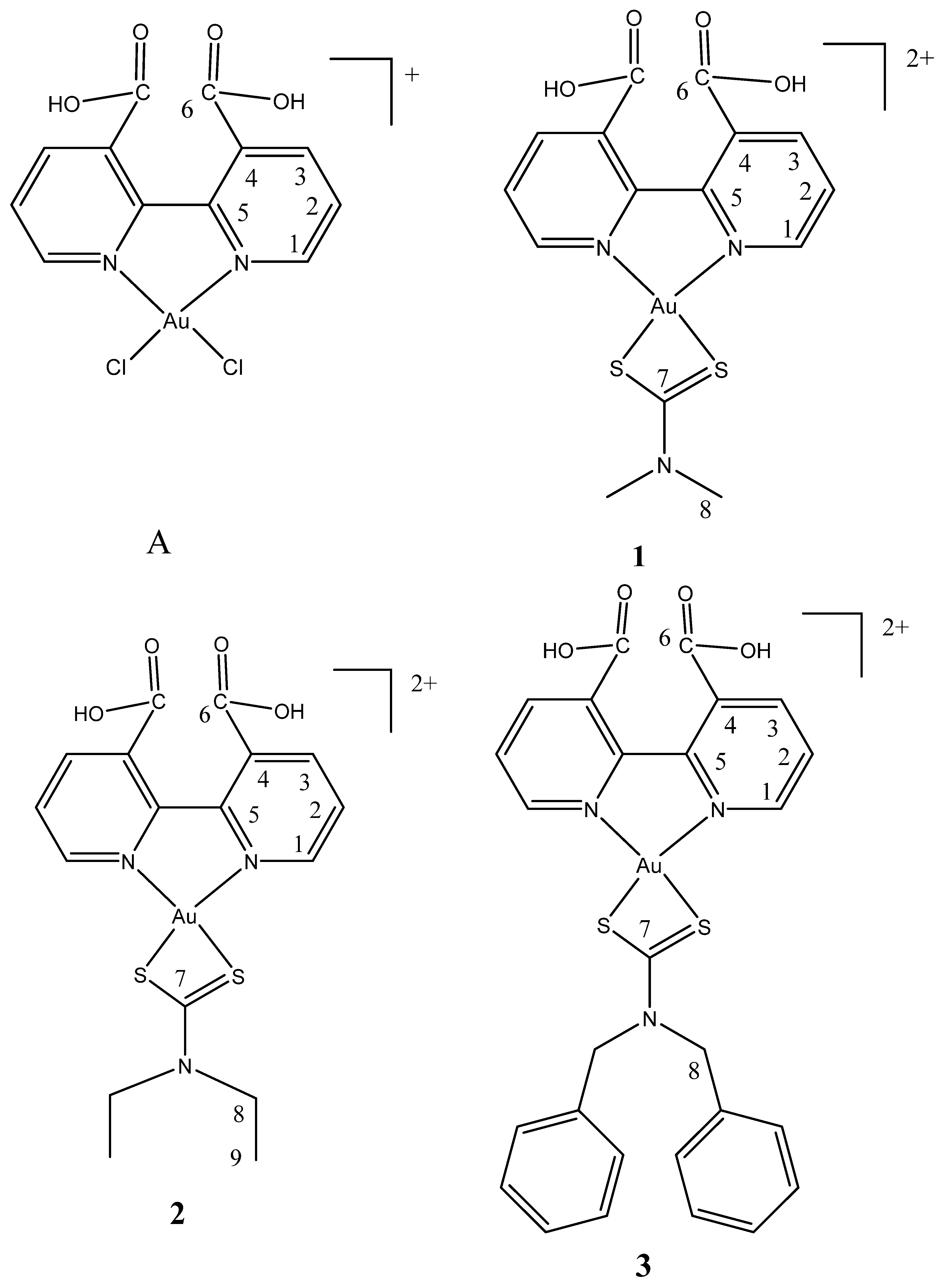
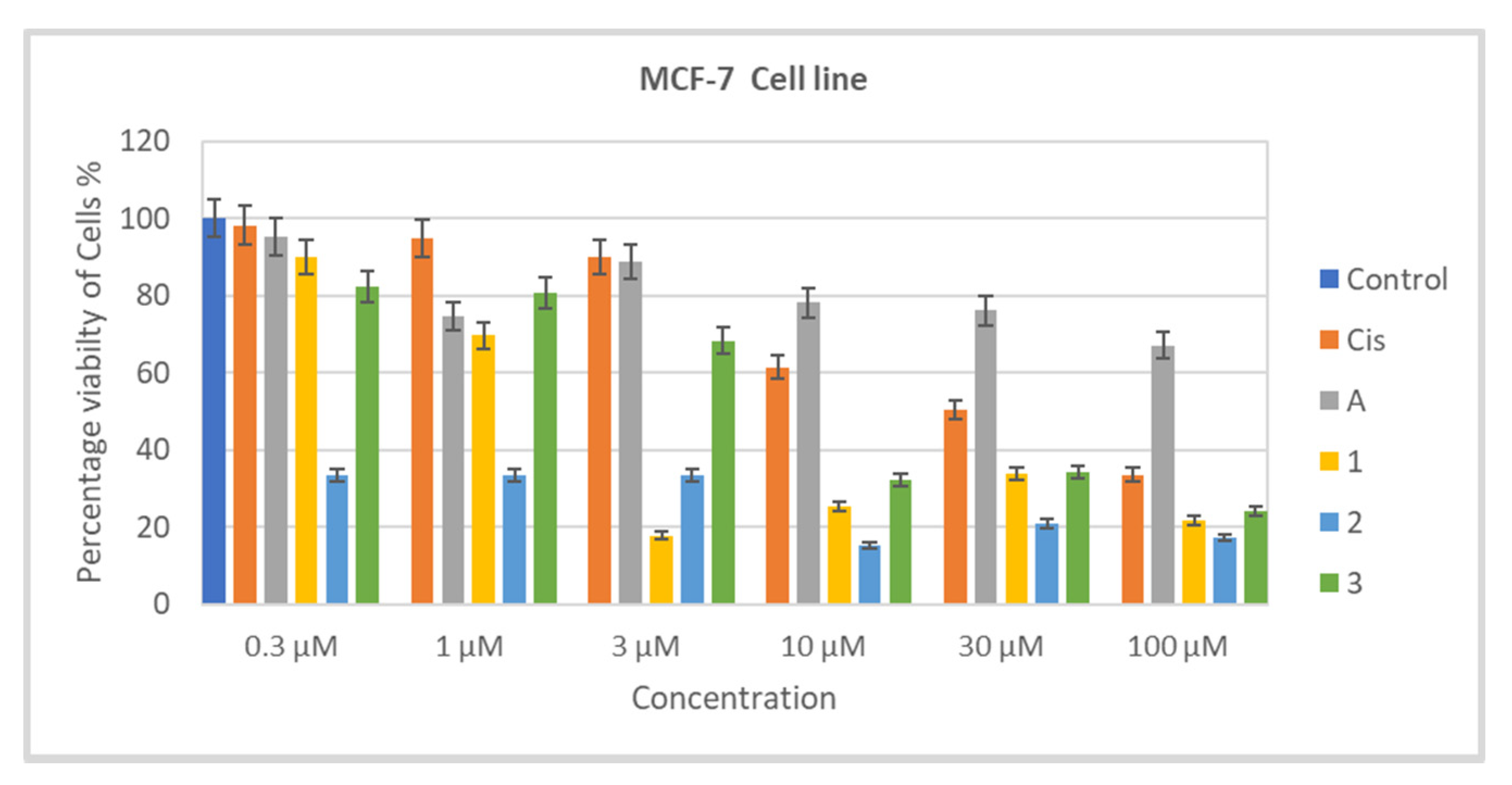
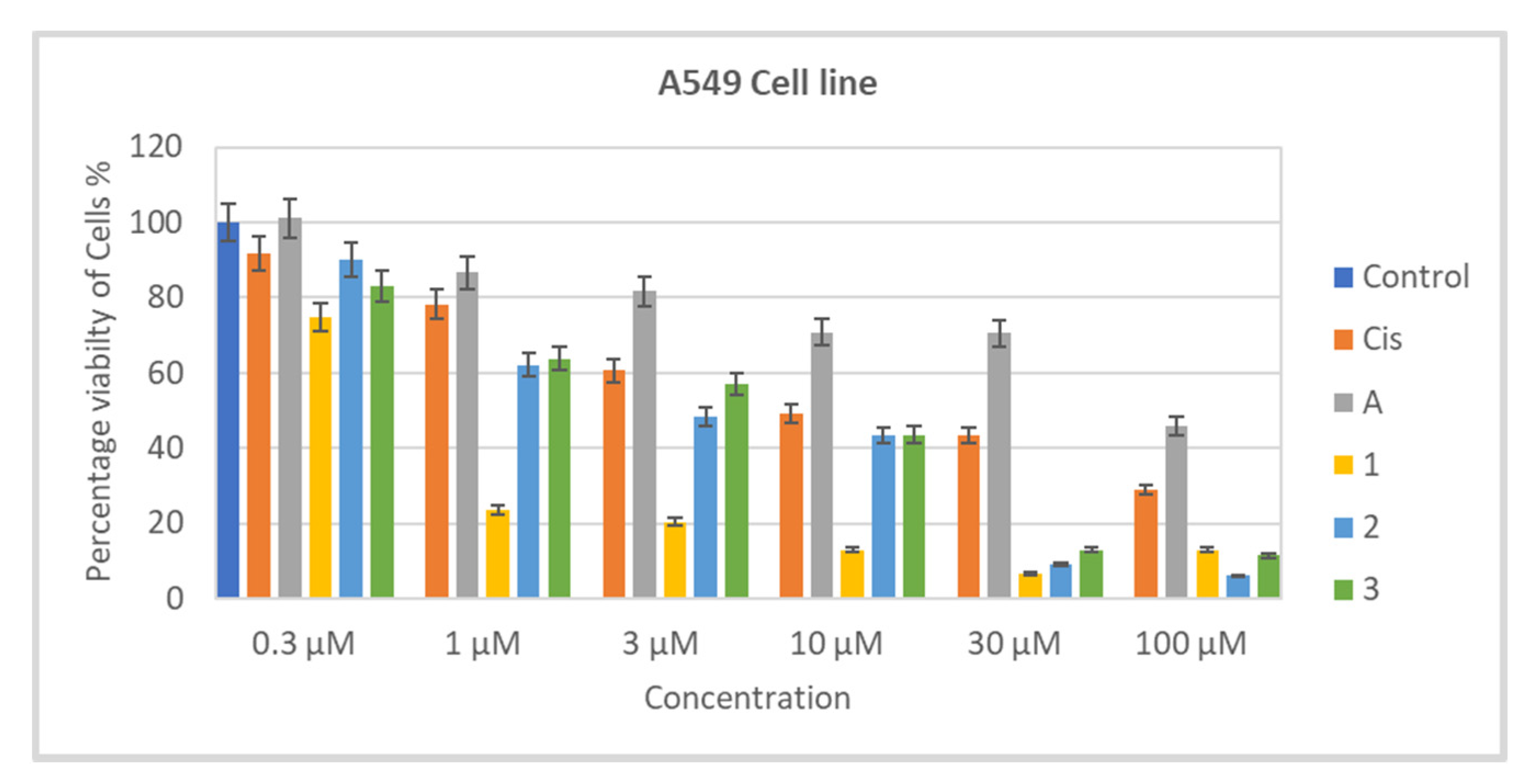
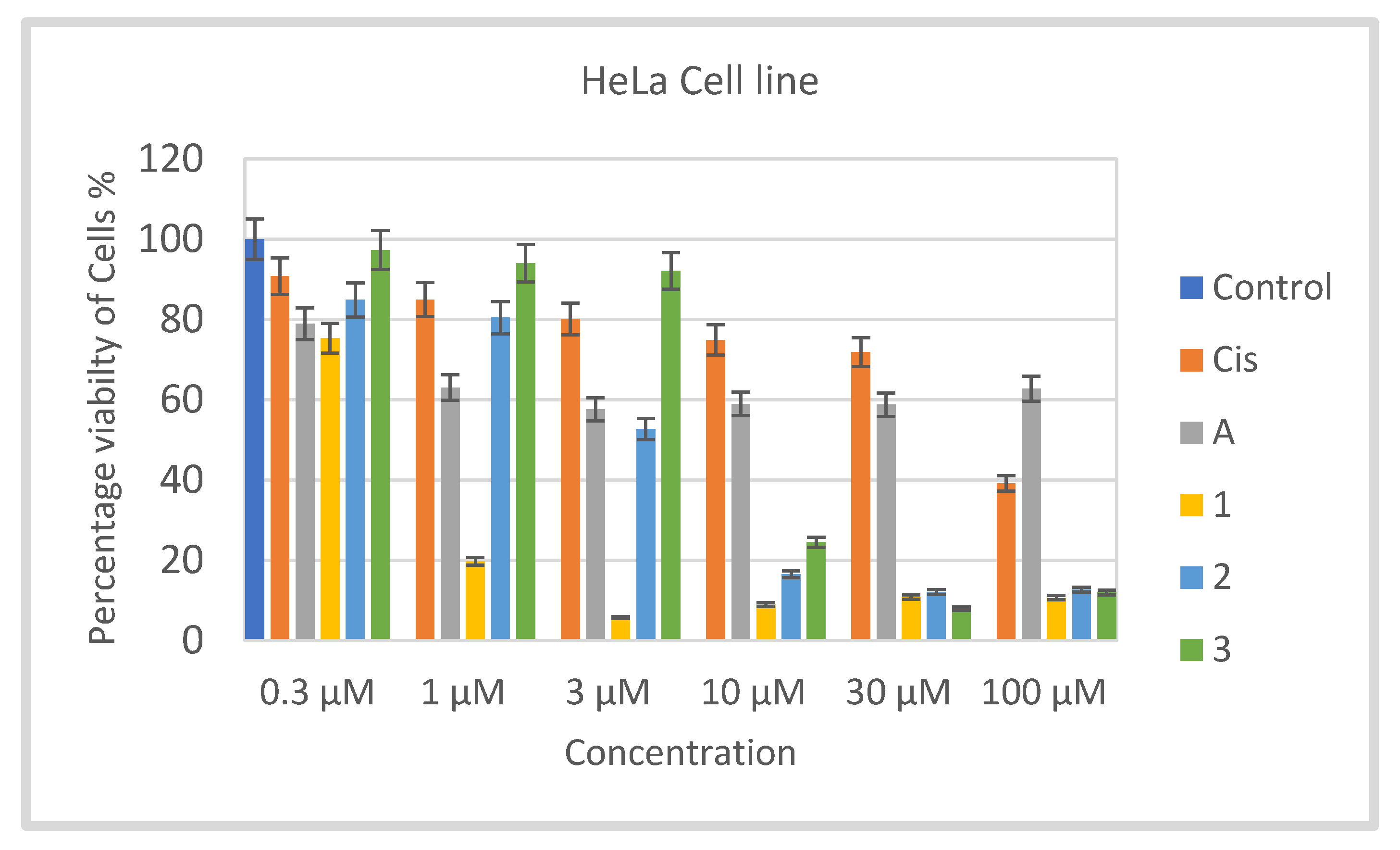
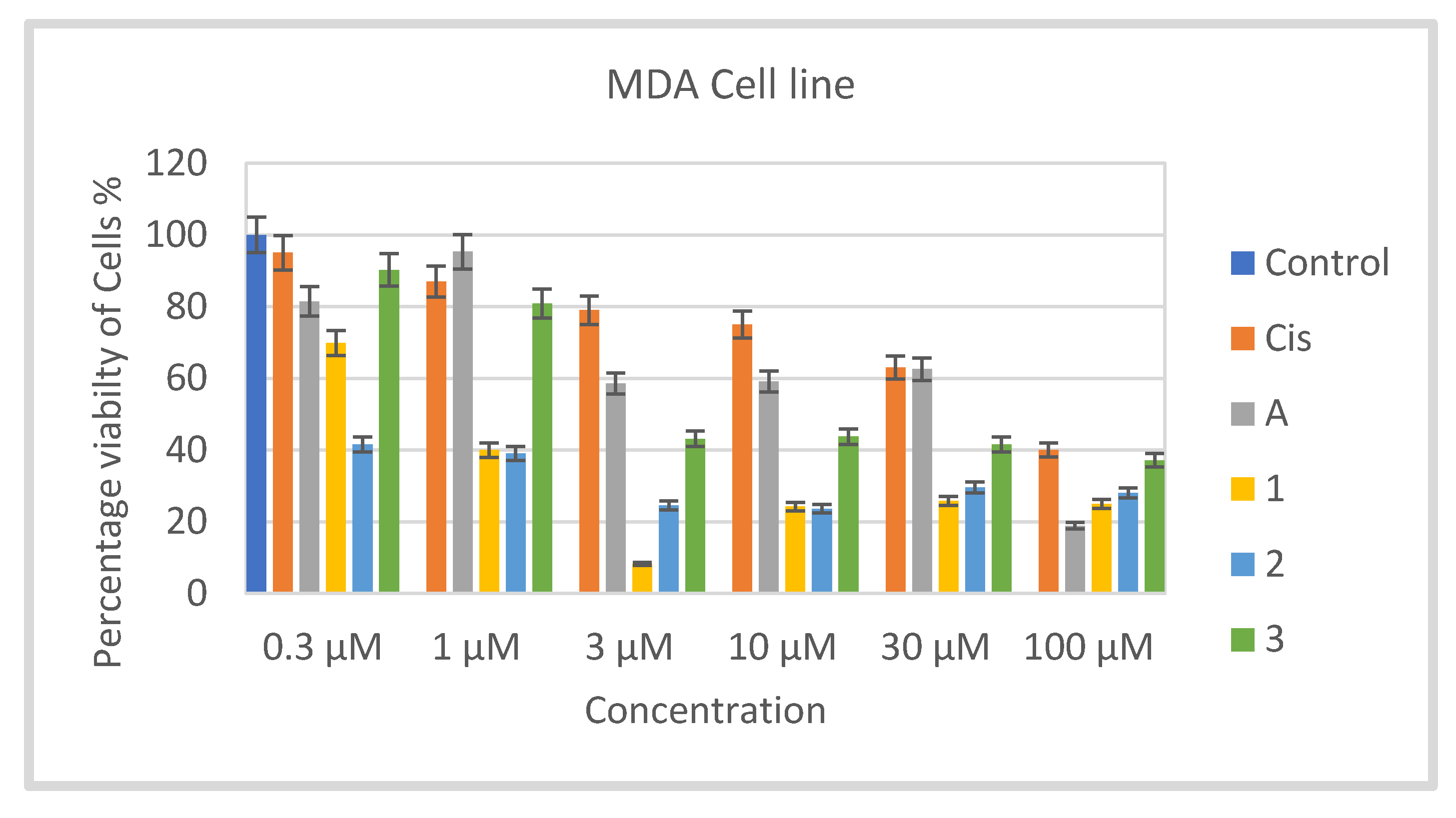
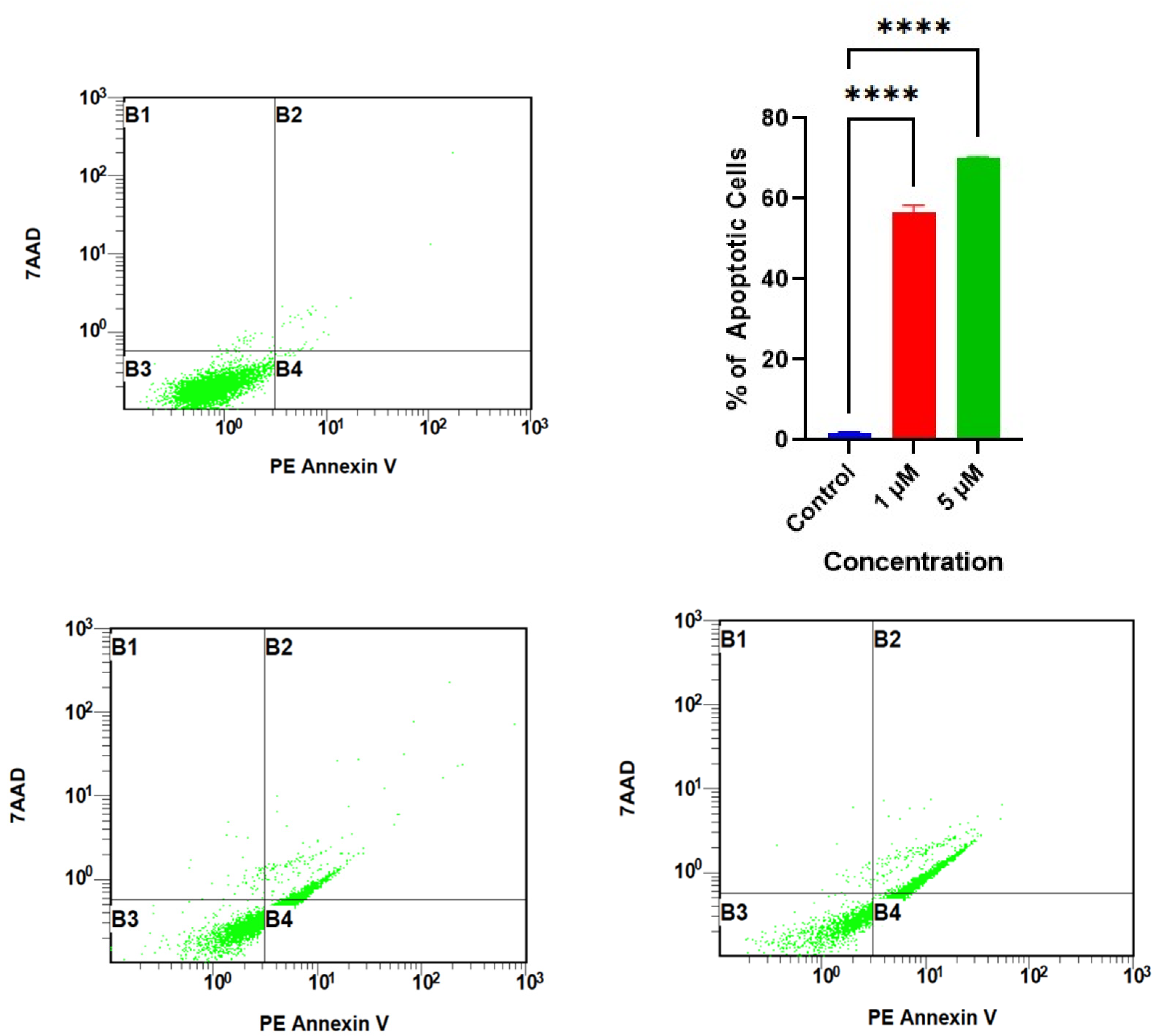
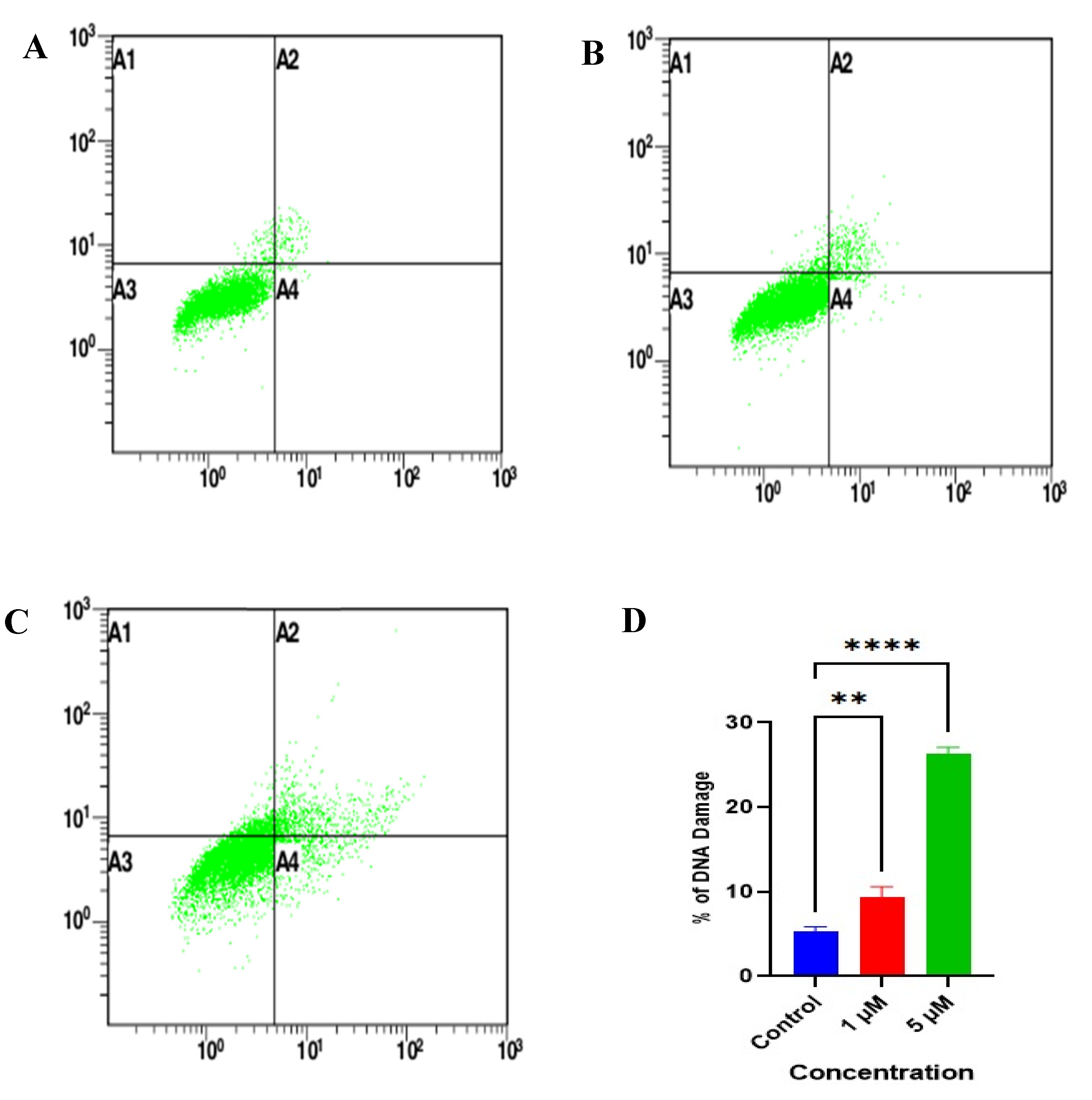
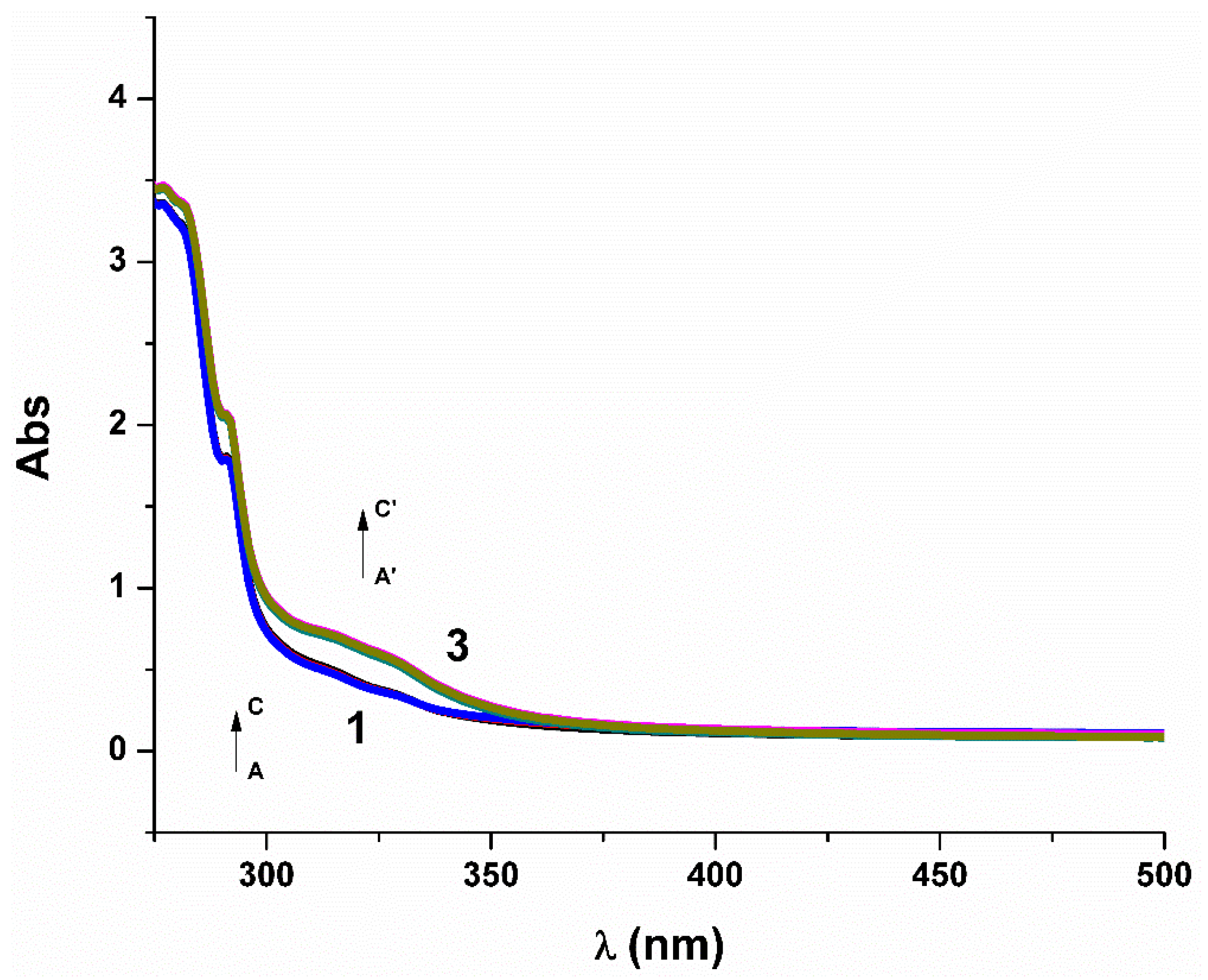
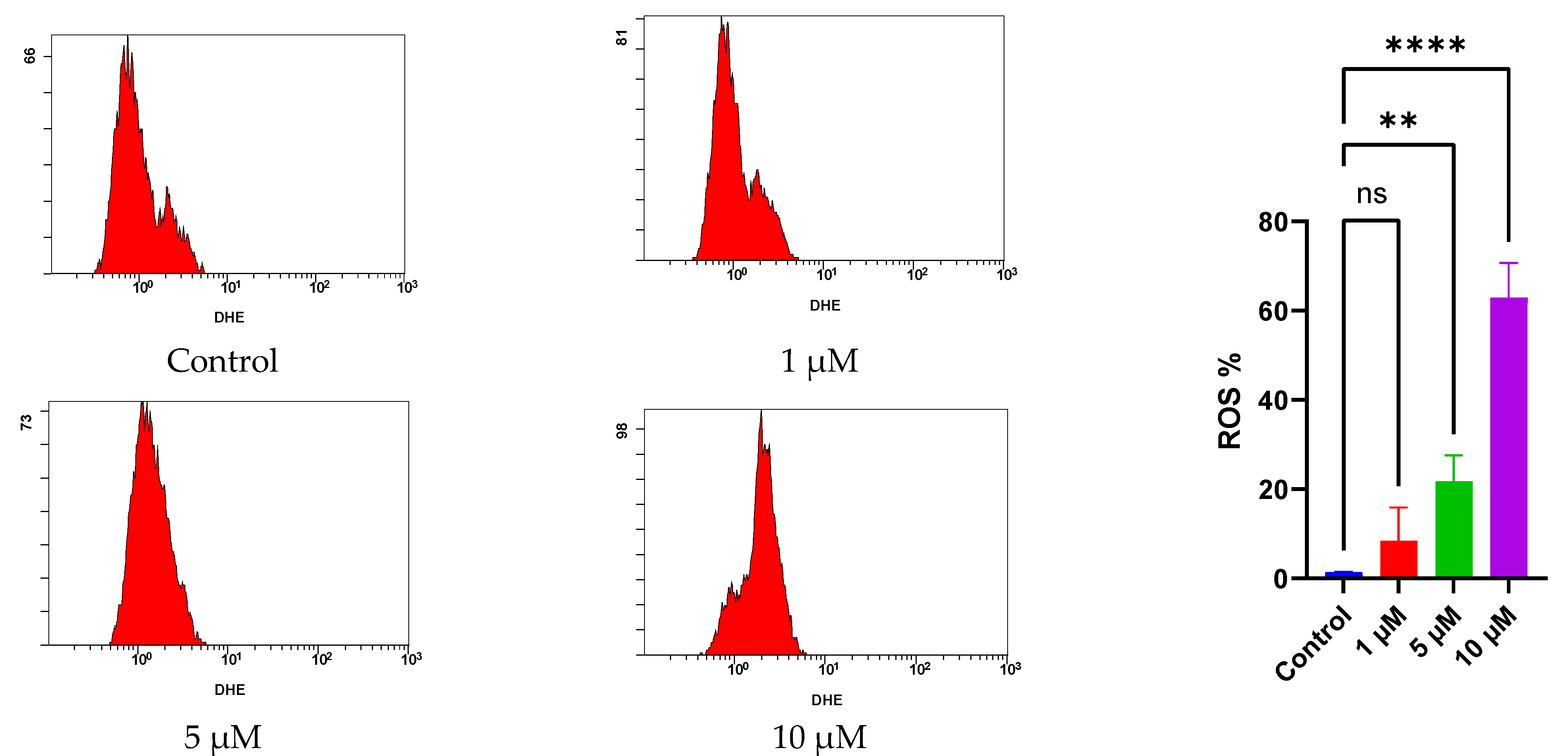
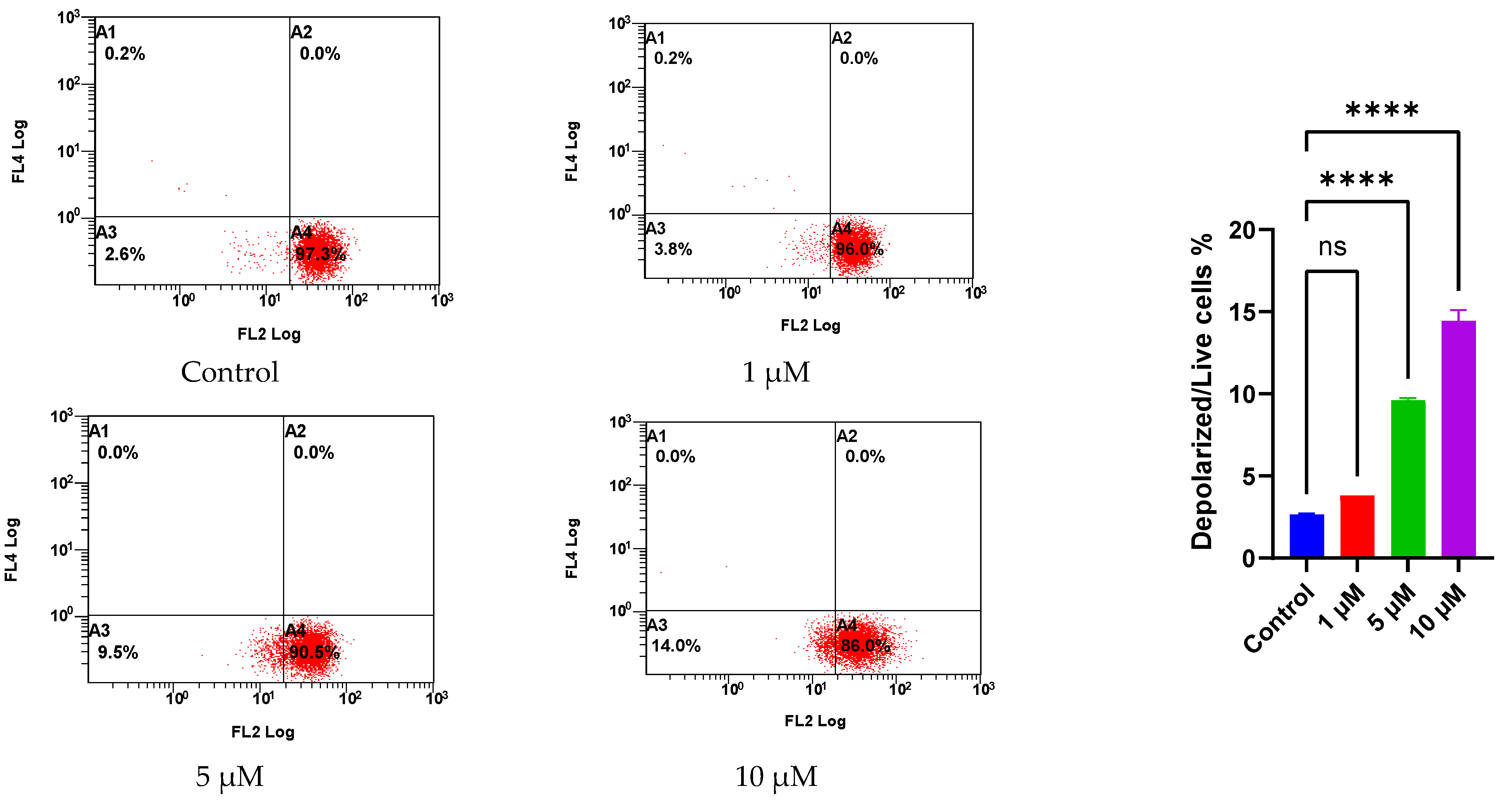
| Ligand/Complex | ν (O-H) | ν (C-H) | ν (COO) | ν (N-CS) | ν (C = C) | ν (CSS) |
|---|---|---|---|---|---|---|
| DMDTC | - | - | - | 1488 | - | 926 |
| DEDTC | - | - | - | 1445 | - | 986 |
| DBDTC | - | 2923, 2854 | 1600 | 1467 | 1436 | 985 |
| A | 3451 | 2953, 2851 | 1645 | - | - | - |
| 1 | 3448 | - | 1652 | 1575 | 1399 | 1047, 967 |
| 2 | 3440 | 2975, 2853 | 1662 | 1550 | 1347 | 1065, 993 |
| 3 | 3439 | 2928, 2854 | 1716 | 1549 | 1435 | 1067, 904 |
| Ligand/Complex | H-1 | H-2 | H-3 | H-6 | H-8 | H-9 | Aromatic-Hs |
|---|---|---|---|---|---|---|---|
| DMDTC | - | - | - | - | 3.35 s | - | - |
| DEDTC | - | - | - | - | 3.93 q | 1.13 t | - |
| DBDTC | - | - | - | - | 5.31, 4.77 d | - | 7.24 m–7.39 m |
| A | 8.71d | 7.58 t | 8.31d | - | - | - | - |
| 1 | 8.67d | 7.52 t | 8.26 d | - | 3.36 s | - | - |
| 2 | 8.69d | 7.56 t | 8.29 d | - | 3.76 q | 1.28 t | - |
| 3 | 8.89d | 7.77 t | 8.78 d | 10.13 | 4.85, 4.76 d | - | 7.22 m–7.33 m |
| Ligand/Complex | C1 | C2 | C3 | C4 | C5 | C6 | C = S | C8 | C9 | Aromatic Cs |
|---|---|---|---|---|---|---|---|---|---|---|
| DMDTC | - | - | - | - | - | - | 208.3 | 45.7 | - | - |
| DEDTC | - | - | - | - | - | - | 206.4 | 49.5 | 12.1 | - |
| DBDTC | - | - | - | - | - | - | 213.1 | 56.9 | - | 127.7–137.2 |
| A | 157.9 | 126.8 | 138.4 | 123.3 | 150.3 | 166.7 | - | - | - | - |
| 1 | 158.8 | 126.6 | 137.8 | 122.8 | 150.6 | 167 | 193.9 | 40.3 | - | - |
| 2 | 158.2 | 126.6 | 138.1 | 123 | 150.3 | 166.7 | 193.8 | 46.5 | 12 | - |
| 3 | 155.9 | 119.4 | 142.8 | 122.8 | 151.2 | 193.4 | 52.1 | - |
| IC50 in μM | ||||
|---|---|---|---|---|
| A549 | HeLa | MDA-231 | MCF-7 | |
| Cisplatin | 9.61 (± 0.08) | 9.3 (± 0.2) | 7.8 (± 0.02) | 31.06 (± 0.1) |
| A | 7.4 (± 0.07) | 7.3 (± 0.03) | 5.5 (± 0.02) | 15.9 (± 0.021) |
| 1 | 3.02 (± 0.1) | 2.8 (± 0.05) | 3.3 (± 0.01) | 4.08 (± 0.019) |
| 2 | 3.08 (± 0.06) | 3.1 (± 0.1) | 3.3 (± 0.01) | 2.7 (± 0.1) |
| 3 | 3.1 (± 0.5) | 3.7 (± 0.07) | 4.1 (± 0.03) | 3.7 (± 0.019) |
Publisher’s Note: MDPI stays neutral with regard to jurisdictional claims in published maps and institutional affiliations. |
© 2021 by the authors. Licensee MDPI, Basel, Switzerland. This article is an open access article distributed under the terms and conditions of the Creative Commons Attribution (CC BY) license (https://creativecommons.org/licenses/by/4.0/).
Share and Cite
Alhoshani, A.; Sulaiman, A.A.A.; Sobeai, H.M.A.; Qamar, W.; Alotaibi, M.; Alhazzani, K.; Monim-ul-Mehboob, M.; Ahmad, S.; Isab, A.A. Anticancer Activity and Apoptosis Induction of Gold(III) Complexes Containing 2,2′-Bipyridine-3,3′-dicarboxylic Acid and Dithiocarbamates. Molecules 2021, 26, 3973. https://doi.org/10.3390/molecules26133973
Alhoshani A, Sulaiman AAA, Sobeai HMA, Qamar W, Alotaibi M, Alhazzani K, Monim-ul-Mehboob M, Ahmad S, Isab AA. Anticancer Activity and Apoptosis Induction of Gold(III) Complexes Containing 2,2′-Bipyridine-3,3′-dicarboxylic Acid and Dithiocarbamates. Molecules. 2021; 26(13):3973. https://doi.org/10.3390/molecules26133973
Chicago/Turabian StyleAlhoshani, Ali, Adam A. A. Sulaiman, Homood M. As Sobeai, Wajhul Qamar, Moureq Alotaibi, Khalid Alhazzani, Muhammad Monim-ul-Mehboob, Saeed Ahmad, and Anvarhusein A. Isab. 2021. "Anticancer Activity and Apoptosis Induction of Gold(III) Complexes Containing 2,2′-Bipyridine-3,3′-dicarboxylic Acid and Dithiocarbamates" Molecules 26, no. 13: 3973. https://doi.org/10.3390/molecules26133973
APA StyleAlhoshani, A., Sulaiman, A. A. A., Sobeai, H. M. A., Qamar, W., Alotaibi, M., Alhazzani, K., Monim-ul-Mehboob, M., Ahmad, S., & Isab, A. A. (2021). Anticancer Activity and Apoptosis Induction of Gold(III) Complexes Containing 2,2′-Bipyridine-3,3′-dicarboxylic Acid and Dithiocarbamates. Molecules, 26(13), 3973. https://doi.org/10.3390/molecules26133973







